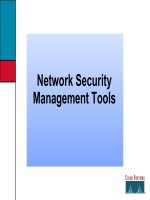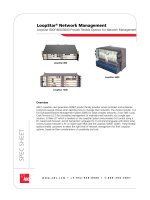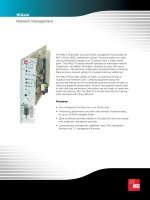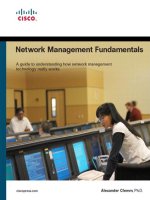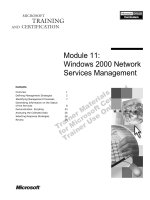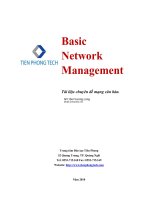Network management chapter313
Bạn đang xem bản rút gọn của tài liệu. Xem và tải ngay bản đầy đủ của tài liệu tại đây (259.62 KB, 70 trang )
Chapter 3
Chapter 3
Basic Foundations:
Standards, Models, and Language
And
Chapter 13
Network Management Applications
1
Network Management: Principles and Practice
© Mani Subramanian 2000
Chapter 3
Introduction
• Standards
• Standards organizations
• Protocol standards of transport layers
• Protocol standards of management
(application) layer
• Management Models
• Language
Notes
2
Network Management: Principles and Practice
© Mani Subramanian 2000
Chapter 3
3
Network Management: Principles and Practice
© Mani Subramanian 2000
Chapter 3
OSI NM Architecture and Model
Network
Mangement
Organization
Model
Information
Model
Communication
Model
Functional
Model
Figure 3.1 OSl Network Management Model
Notes
• Organization model
• Network management components
• object, agent, and manager
• Functions of components
• Relationships
• Information model
• Structure of management information (SMI)
• Syntax and semantics
• Management information base (MIB)
• Organization of management information
• Object-oriented
4
Network Management: Principles and Practice
© Mani Subramanian 2000
Chapter 3
OSI NM Architecture and Model
Network
Mangement
Organization
Model
Information
Model
Communication
Model
Functional
Model
Figure 3.1 OSl Network Management Model
Notes
• Communication model
• Transfer syntax with bi-directional messages
• M-SET, M-GET
• Transfer structure (PDU)
• Functional model – User oriented requirements of NM
• Application functions (Covered in chapter 13)
• Configure components (CM)
• Monitor components (FM)
• Measure performance (PM)
• Secure information (SM)
• Usage accounting (AM)
5
Network Management: Principles and Practice
© Mani Subramanian 2000
Chapter 3
SNMP Architecture and Model
(Not defined explicitly)
Network
Mangement
Organization
Model
Information
Model
Communication
Model
Functional
Model
Figure 3.1 OSl Network Management Model
Notes
• Organization model
• Same as OSI model
• Information model
• Same as OSI, but scalar
•Communication model
• Messages less complex than OSI
and unidirectional (request, response)
• Transfer structure (PDU)
• Functional model
• Application functions in terms of
• Operations (get, set)
• Administration – who has access to what
• Security – community-based
6
Network Management: Principles and Practice
© Mani Subramanian 2000
Chapter 3
TMN Architecture
• Addresses management of telecommunication
networks
• Based on OSI model
• Superstructure on OSI network
• Addresses network, service, and business
management
• See chapter 11 for more details
7
Network Management: Principles and Practice
© Mani Subramanian 2000
Chapter 11
Example (NMF)
TMN Logical
Layered Architecture
Business
Management
Physical Realization of
TMN Architecture
Customer
Service
Management
q3
Ref. Point
Q3
Service
Details
Service
Management
q3
Ref. Point
Service Mgmt
Tarif /Charging
Service Mgmt
Provisioning
Service
Configuration
Network
Management
q3
Ref. Point
Net Mgmt
Routing Admin
Net Element
Cust Admin
Service Mgmt
Other
Q3
Serviceimpacting
Events
Net Mgmt
Traffic Admin
Equipment
Configuration
Element
Management
Performance and
Billing Data
Net Mgmt
Restoration
Q3
Equipment
Alarms
Net Element
Trans Eqpt
Mgmt
Net Element
Switch Mgmt
Figure 11.14 TMN Realization Example (NMF)
8
Network Management: Principles and Practice
© Mani Subramanian 2000
Chapter 3
Organization Model
• Manager
• Manages the managed elements
• Sends requests to agents, retrieves
management information & stores it in MDB
• Monitors alarms – unsolicited
traps/notifications from agents
• Houses applications, e.g., CM, FM, etc.
• Provides user interface, e.g., HPOpenview
• Agent
• Gathers information from objects – get
• Configures parameters of objects – set
• Responds to managers’ requests –
response
• Generates alarms and sends them to
managers (unsolicited) – trap
• Managed object
• Network element that is managed, e.g.,
hubs, bridges, etc.
• Houses management agent – process
running
• All objects are either not managed or
manageable (more expensive)
9
Network Management: Principles and Practice
© Mani Subramanian 2000
Chapter 3
Two-Tier Model
Manager
MDB
Managed objects
Unmanaged objects
MDB Management Database
Agent process
Figure 3.2 Two-Tier Network Mangement Organization Model
Notes
• Agent built into network element
Example: Managed hub, managed router
• A manager can manage multiple elements
Example: Switched hub, ATM switch
• MDB is a physical database
• Unmanaged objects are network elements
that are not managed - both physical (unmanaged
hub) and logical (passive elements)
10
Network Management: Principles and Practice
© Mani Subramanian 2000
Chapter 3
Three-Tier Model
MDB
Manager
MDB
Agent / Manager
Managed objects
MDB Management Database
Agent process
Figure 3.3 Three-Tier Network Mangement Organization Model
Notes
• Middle layer plays the dual role
• Agent to the top-level manager
• Manager to the managed objects - e.g., collects data
• Example of middle level: Remote monitoring
agent (RMON)
• Examples:
• Statistical measurement on a network
• Local site passes information to a remote site
11
Network Management: Principles and Practice
© Mani Subramanian 2000
Chapter 3
Manager of Managers
MoM
MDB
Agent
Agent
Agent NMS
Agent NMS
MDB
Manager
MDB
Manager
Managed objects
Managed objects
Agent NMS
MoM Manager of Managers
MDB Management Database
Agent
Manager
Agent process
Figure 3.4 Network Mangement Organization Model with MoM
Notes
• Agent NMS manages the domain
• MoM presents integrated view of domains
• Domain may be geographical (cities), administrative
(departments), vendor-specific products (Cisco), etc.
12
Network Management: Principles and Practice
© Mani Subramanian 2000
Chapter 3
Peer NMSs
Agent NMS
Manager NMS
Manager NMS
Agent NMS
Figure 3.5 Dual Role of Management Process
Notes
• NMSs configured in a peer-to-peer relationship
• Network management system acts as peers
• Dual role of both NMSs
• Example: Two network service providers exchange
Management information
• Dumbbell architecture discussed in Chapter 1
• Notice that the manager and agent functions are
processes and not systems
13
Network Management: Principles and Practice
© Mani Subramanian 2000
Chapter 1
Interoperability
Messages
NMS
Vendor A
NMS
Vendor B
Services & Protocols
Network
Agent
Network
Agent
Network
Agent
Network
Agent
Network
Objects
Network
Objects
Network
Objects
Network
Objects
Objects
Vendor A
Objects
Application
Services
Management
Protocol
Objects
Vendor B
Objects
Transport
Protocols
(b) Services and Protocols
Figure 1.23 Network Management Dumbbell Architecture
Notes
• Message exchange between NMSs managing
different domains
14
Network Management: Principles and Practice
© Mani Subramanian 2000
Chapter 3
Information Model:
Analogy
• Information model – Structure & storage of information
• Figure in a book uniquely identified by
• ISBN, Chapter, and Figure number in that
hierarchical order
• ID: {ISBN, chapter, figure} – Hierarchy of designation
• The three elements above define the syntax – format
• Semantics is the meaning of the three
entities according to Webster’s dictionary
• The information comprises syntax and semantics
about an object
Notes
• Management information model =
objects representation (SMI) +
management information of objects (MIB)
• SMI defines the syntax & semantics of management
information stored in the MIB
• Information model specifies the information base to
describe managed objects and their relationships
(i.e., MIB)
15
Network Management: Principles and Practice
© Mani Subramanian 2000
Chapter 3
Structure of Management Information
(SMI)
• SMI defines for a managed object:
• Syntax
• Semantics – i.e., definition
• plus additional information such as status
• Example
sysDescr:
{ system 1 }
Syntax:
OCTET STRING
Definition: "A textual description of the entity. "
Access:
read-only
Status:
mandatory
Notes
• Uses ASN.1: Abstract Syntax Notation One
• See RFC 1155:
• Section 4. Managed objects
• Section 4.3. Macros
16
Network Management: Principles and Practice
© Mani Subramanian 2000
Chapter 3
Management Information Base (MIB)
• Used by manager & agents to store & exchange
management information
• Information base contains information about objects
• Organized by grouping of related objects (e.g., IP group)
• Defines relationship between objects (e.g., object system
is a parent of object sysDescr)
• It is NOT a physical database. It is a virtual
database that is compiled into management module
Notes
• The agent MIB is used for accessing local information
requested by the manager, and sending a response back
• The manager MIB is used for accessing information
on all network components the manager manages.
• See RFC 1213
17
Network Management: Principles and Practice
© Mani Subramanian 2000
Chapter 3
Information Base View: An Analogy
• Fulton County library system has many branches
• Each branch has a set of books
• The books in each branch is a different set
• The information base of the county has the
view (catalog) of all books
• The information base of each branch has the
catalog of books that belong to that branch.
That is, each branch has its view (catalog) of
the information base
• Let us apply this to MIB view
Notes
18
Network Management: Principles and Practice
© Mani Subramanian 2000
Chapter 3
MIB View and Access of an Object
• A managed object has many attributes - its
information base (e.g., IPAddress, # of ports)
• There are several operations that can be
performed on the objects (get, set)
• A user (manager) can view and perform only
certain operations on the object by invoking
the management agent – privileges depends on
the user and the managed object
• The view of the object attributes that the agent
perceives is the MIB view
• The operation that a user can perform is the
MIB access
Notes
19
Network Management: Principles and Practice
© Mani Subramanian 2000
Chapter 3
Management Data Base / Information Base
Manager
MDB
MIB
MDB Management Database
MIB Management Information Base
Agent process
Managed objects
Figure 3.6 Network Configuration with Data and Information Base
Notes
• Distinction between MDB and MIB
• MDB physical database; e.g.. Oracle, Sybase
• MIB virtual database; schema compiled into
management software (for processes to
exchange information)
• An NMS can automatically discover a managed
object, such as a hub, when added to the network
• The NMS can identify the new object as hub only
after the MIB schema of the hub is compiled into
NMS software
20
Network Management: Principles and Practice
© Mani Subramanian 2000
Chapter 3
Managed Object
• Managed objects can be
• Network elements (hardware, system)
• hubs, bridges, routers, transmission facilities
• Software (non-physical)
• programs, algorithms
• Administrative information
• contact person, name of group of objects
(IP group)
Notes
• In fact, any type of info that can be included in the
MIB can be managed.
21
Network Management: Principles and Practice
© Mani Subramanian 2000
Chapter 3
Management Information Tree
Root
Level 1
Level 2
Level 3
Figure 3.7 Generic Representation of Management Information Tree
Notes
22
Network Management: Principles and Practice
© Mani Subramanian 2000
Chapter 3
OSI Management Information Tree
itu
0
iso
1
iso-itu
2
org
3
dod
6
internet
1
Figure 3.8
OSI Management Information Tree
Notes
• iso
International Standards Organization
itu
International Telecommunications Union
dod Department of Defense
• Designation:
• iso
1
• org
1.3
• dod
1.3.6
• internet 1.3.6.1 – all internet managed
objects will start with this
23
Network Management: Principles and Practice
© Mani Subramanian 2000
Chapter 3
Object Type and Instance
• Type
• Name
• Syntax
• Definition
• Status
• Access
• Instance
Notes
• Example of a circle
• “circle” is syntax
• Semantics is definition from dictionary
“A plane figure bounded by a single curved
line, every point of which is of equal distance
from the center of the figure.”
• Analogy of nursery school
24
Network Management: Principles and Practice
© Mani Subramanian 2000
Chapter 3
Managed Object:
Internet Perspective
Access:
Access
privilege
Object Type:
Object ID
Descriptor
circle
and
Status
Implementaion
requirements
Syntax
model of object
:
Defintion
Semantics textual description
:
:
Figure 3.9(a) Internet Perspective
Notes
•object ID
unique ID
•and descriptor
•syntax
and name for the object
used to model the object
•access
access privilege to a managed object
•status
implementation requirements
•definition
textual description of the semantics
of object type
25
Network Management: Principles and Practice
© Mani Subramanian 2000
